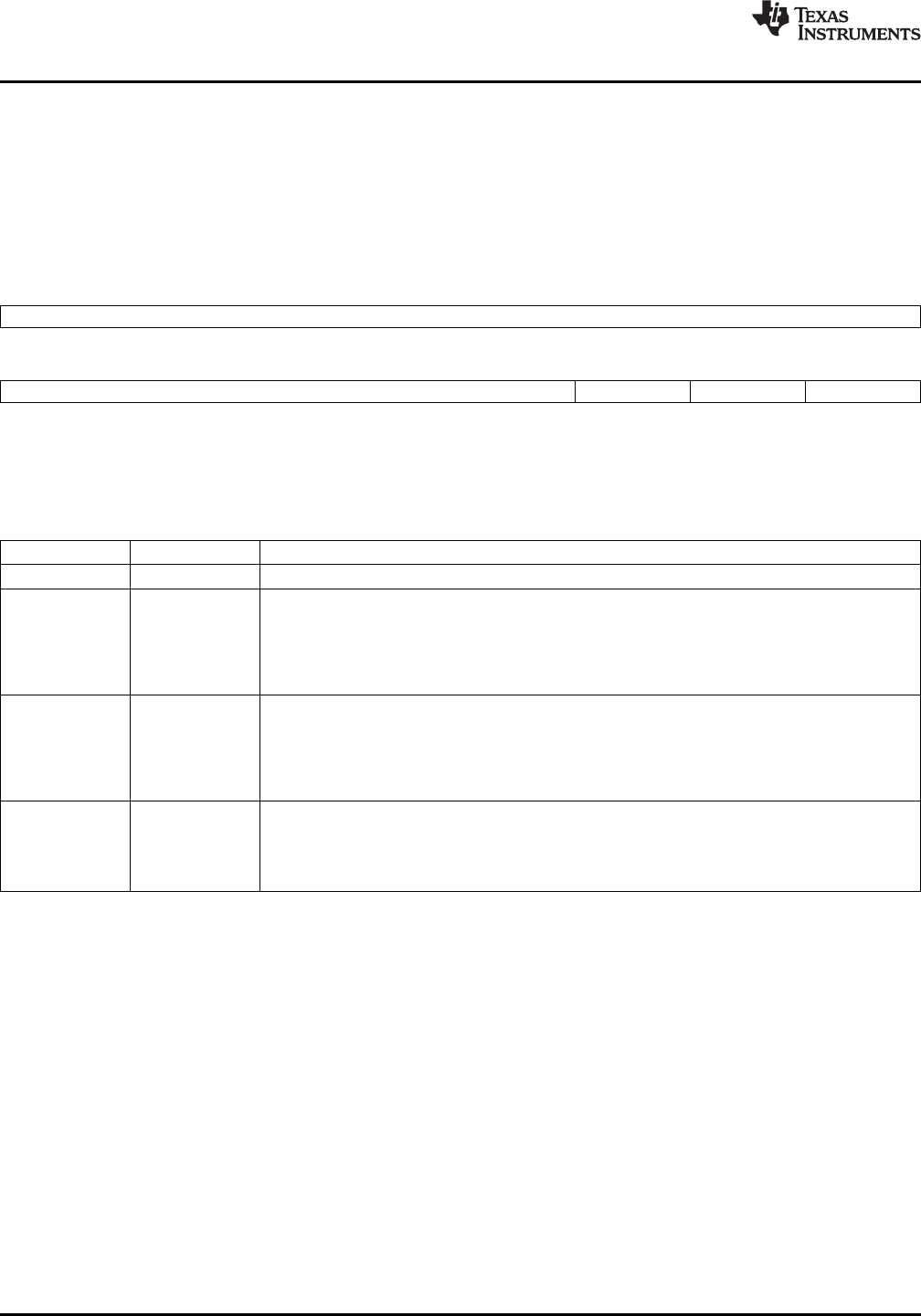Datasheet
Table Of Contents
- 1 Digital Media System-on-Chip (DMSoC)
- Table of Contents
- 2 Revision History
- 3 Device Overview
- 3.1 Device Characteristics
- 3.2 Device Compatibility
- 3.3 ARM Subsystem
- 3.3.1 ARM926EJ-S RISC CPU
- 3.3.2 CP15
- 3.3.3 MMU
- 3.3.4 Caches and Write Buffer
- 3.3.5 Tightly Coupled Memory (TCM)
- 3.3.6 Advanced High-Performance Bus (AHB)
- 3.3.7 Embedded Trace Macrocell (ETM) and Embedded Trace Buffer (ETB)
- 3.3.8 ARM Memory Mapping
- 3.3.9 Peripherals
- 3.3.10 PLL Controller (PLLC)
- 3.3.11 Power and Sleep Controller (PSC)
- 3.3.12 ARM Interrupt Controller (AINTC)
- 3.3.13 System Module
- 3.3.14 Power Management
- 3.4 DSP Subsystem
- 3.5 Memory Map Summary
- 3.6 Pin Assignments
- 3.7 Terminal Functions
- 3.8 Device Support
- 3.9 Documentation Support
- 3.10 Community Resources
- 4 Device Configurations
- 4.1 System Module Registers
- 4.2 Power Considerations
- 4.3 Clock Considerations
- 4.4 Boot Sequence
- 4.5 Configurations At Reset
- 4.6 Configurations After Reset
- 4.7 Multiplexed Pin Configurations
- 4.7.1 Pin Muxing Selection At Reset
- 4.7.2 Pin Muxing Selection After Reset
- 4.7.3 Pin Multiplexing Details
- 4.7.3.1 PCI, HPI, EMIFA, and ATA Pin Muxing
- 4.7.3.2 PWM Signal Muxing
- 4.7.3.3 TSIF0 Input Signal Muxing (Serial/Parallel)
- 4.7.3.4 TSIF0 Output Signal Muxing (Serial/Parallel)
- 4.7.3.5 TSIF1 Input Signal Muxing (Serial Only)
- 4.7.3.6 TSIF1 Output Signal Muxing (Serial Only)
- 4.7.3.7 CRGEN Signal Muxing
- 4.7.3.8 UART0 Pin Muxing
- 4.7.3.9 UART1 Pin Muxing
- 4.7.3.10 UART2 Pin Muxing
- 4.7.3.11 ARM/DSP Communications Interrupts
- 4.7.3.12 Emulation Control
- 4.8 Debugging Considerations
- 5 System Interconnect
- 6 Device Operating Conditions
- 7 Peripheral Information and Electrical Specifications
- 7.1 Parameter Information
- 7.2 Recommended Clock and Control Signal Transition Behavior
- 7.3 Power Supplies
- 7.4 External Clock Input From DEV_MXI/DEV_CLKIN and AUX_MXI/AUX_CLKIN Pins
- 7.5 Clock PLLs
- 7.6 Enhanced Direct Memory Access (EDMA3) Controller
- 7.7 Reset
- 7.8 Interrupts
- 7.9 External Memory Interface (EMIF)
- 7.10 DDR2 Memory Controller
- 7.10.1 DDR2 Memory Controller Electrical Data/Timing
- 7.10.2 DDR2 Interface
- 7.10.2.1 DDR2 Interface Schematic
- 7.10.2.2 Compatible JEDEC DDR2 Devices
- 7.10.2.3 PCB Stackup
- 7.10.2.4 Placement
- 7.10.2.5 DDR2 Keep Out Region
- 7.10.2.6 Bulk Bypass Capacitors
- 7.10.2.7 High-Speed Bypass Capacitors
- 7.10.2.8 Net Classes
- 7.10.2.9 DDR2 Signal Termination
- 7.10.2.10 VREF Routing
- 7.10.2.11 DDR2 CK and ADDR_CTRL Routing
- 7.11 Video Port Interface (VPIF)
- 7.12 Transport Stream Interface (TSIF)
- 7.13 Clock Recovery Generator (CRGEN)
- 7.14 Video Data Conversion Engine (VDCE)
- 7.15 Peripheral Component Interconnect (PCI)
- 7.16 Ethernet MAC (EMAC)
- 7.17 Management Data Input/Output (MDIO)
- 7.18 Host-Port Interface (HPI) Peripheral
- 7.19 USB 2.0 [see Note]
- 7.20 ATA Controller
- 7.21 VLYNQ
- 7.22 Multichannel Audio Serial Port (McASP0/1) Peripherals
- 7.23 Serial Peripheral Interface (SPI)
- 7.24 Universal Asynchronouse Receiver/Transmitter (UART)
- 7.25 Inter-Integrated Circuit (I2C)
- 7.26 Pulse Width Modulator (PWM)
- 7.27 Timers
- 7.28 General-Purpose Input/Output (GPIO)
- 7.29 IEEE 1149.1 JTAG
- 8 Mechanical Packaging and Orderable Information

TMS320DM6467T
SPRS605C –JULY 2009–REVISED JUNE 2012
www.ti.com
4.7.2.2 PINMUX1 Register Description
The Pin Multiplexing 1 Register controls the pin function in the UART0, UART1, and UART2 Blocks. The
PINMUX1 register format is shown in Figure 4-19 and the bit field descriptions are given in Table 4-23.
Some muxed pins are controlled by more than one PINMUX bit field. For the combination of the PINMUX
bit fields that control each muxed pin, see Section 4.7.3, Pin Multiplexing Details. For the pin-by-pin
muxing control of the UART0, UART1, and UART2 Blocks, see Section 4.7.3.8, UART0 Pin Muxing;
Section 4.7.3.9, UART1 Pin Muxing; and Section 4.7.3.10, UART2 Pin Muxing.
31 16
RESERVED
R-0000 0000 0000 0000
15 6 5 4 3 2 1 0
RESERVED UART2CTL UART1CTL UART0CTL
R-0000 0000 00 R/W-00 R/W-00 R/W-00
LEGEND: R/W = Read/Write; R = Read only; -n = value after reset
Figure 4-19. PINMUX1 Register
Table 4-23. PINMUX1 Register Bit Descriptions
BIT NAME DESCRIPTION
31:6 RESERVED Reserved. Read returns "0".
UART2 Pin Configuration (see Section 4.7.3.10, UART2 Pin Muxing).
00 = UART function with flow control.
01 = UART function without flow control.
5:4 UART2CTL
10 = IrDA/CIR function.
11 = GPIO function.
(Individual pin functions may be overridden by TSPIMUX, CRGEN0, and CRGEN1 values.)
UART1 Pin Configuration (see Section 4.7.3.9, UART1 Pin Muxing).
00 = UART function with flow control.
01 = UART function without flow control.
3:2 UART1CTL
10 = IrDA/CIR function.
11 = GPIO function.
(Individual pin functions may be overridden by TSPIMUX and TSPOMUX values.)
UART0 Pin Configuration (see Section 4.7.3.8, UART0 Pin Muxing).
00 = UART function with modem control.
1:0 UART0CTL 01 = UART function without modem control.
1x = IrDA/CIR function.
(Individual pin functions may be overridden by TSPOMUX value.)
112 Device Configurations Copyright © 2009–2012, Texas Instruments Incorporated
Submit Documentation Feedback
Product Folder Link(s): TMS320DM6467T










